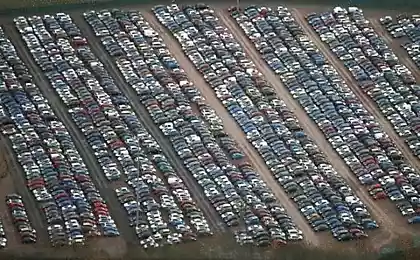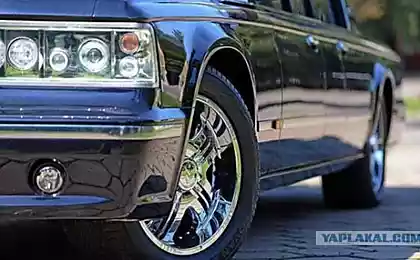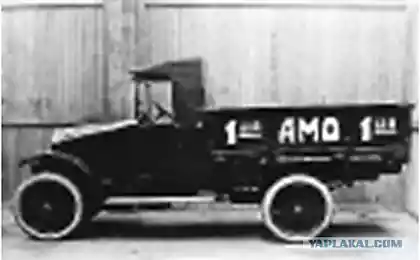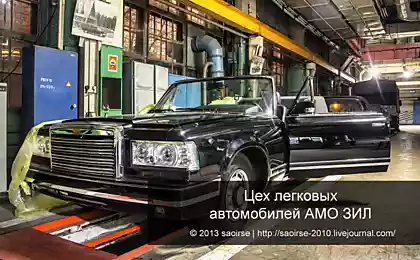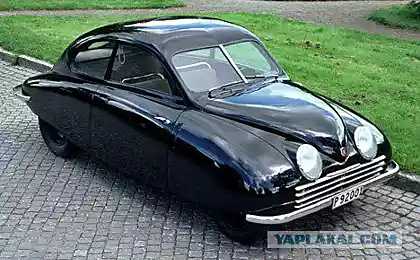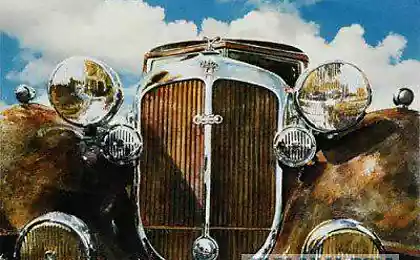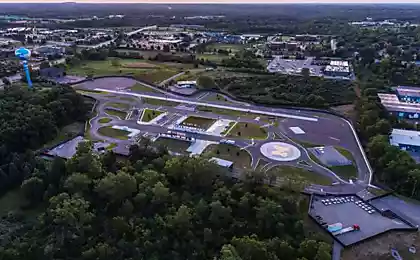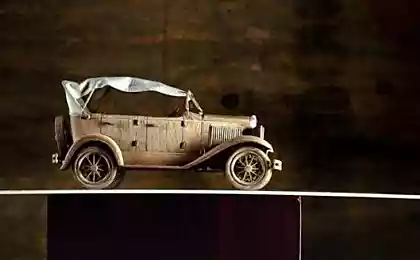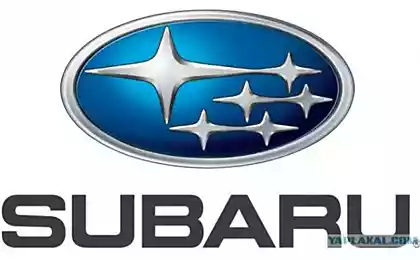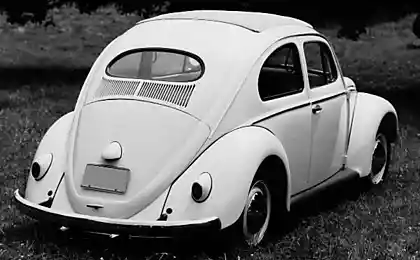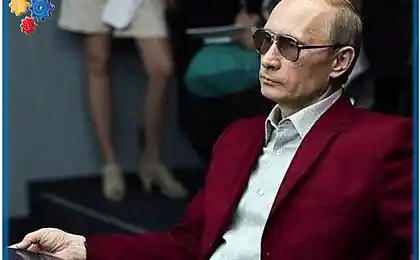1312
20 funniest cars in the world
The Peanuts Movie: 20 funniest cars in the world
On this day, exactly 75 years ago there was a very entertaining event. April 28, 1939 On his debut Crosley Series 1A - the first American microcar!

Avtomobilchik with a wheelbase of two meters, 10 hp 600 cc engine from a lawn sprayer and extremely curious and charming appearance itself. Yet it is important that the anniversary Crosley gave us the occasion to remember the microcar as such - cars, cars for which some believe not all.
What is generally considered microcar? Strict dogmatic formulations do not exist. As there is no single accepted name for such vehicles. In Japan they are called key-penalties, in the UK at the time was a popular term "bubble-Kars" (car-bubbles), the Soviet Union was called kids minicars and sometimes invalidkoy. Choose on taste!
For the vast tribe of automotive small things can safely reckon cars of no more than 3, 5 meters and engine capacity of up to 1 liter and the interior, as a rule, no more than two persons. However, sometimes seating ranges, as well as the number of doors, wheels and cylinders.
Well, perhaps that's enough science-boredom. Now is the time to arrange in order of most-most microcars of the past years. Gentlemen, crank your motors!
Posted in [mergetime] 1398671894 [/ mergetime]
1. MOST AMERICAN - CROSLEY 1A (USA 1939)
The culprit of today's historical perspective curious by the fact that he was born overseas. For the Yankees, as is well known, even in the most difficult periods of its history flatly refused to ride on small cars. What has prompted Powell Crosley, inventor, businessman and a millionaire of Cincinnati, to start production of subcompact? That is still a mystery ...
Posted in [mergetime] 1398671942 [/ mergetime]
We offer a wide range of bodies: a sedan, station wagon, convertible and even an SUV. And one time, it seemed - Mr. Crosley plan might work. In 1948, sales exceeded 28 thousand microcar. Alas, on the successfully completed. Big Detroit trio steadily increasing post-war production, offering more and more new, large, powerful and inexpensive cars. The Americans turned away from the corny kids. However, as you would expect ...
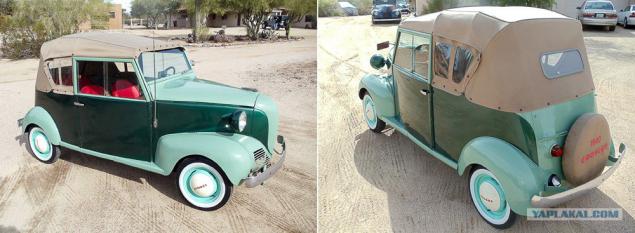
2. MOST ELECTRIC - FAURE PFA (FRANCE 1940) / PEUGEOT VLV (France, 1941)
The root cause of the emergence of ultra-compact car - it's limitations. Restrictions in turn can be very different from the low purchasing power of the population ... to the requirements of the occupation authorities. In 1940, German troops occupied France, Paris and the new owners immediately banned local automobile companies to produce gasoline cars. All fuel is passed to the needs of the Wehrmacht.
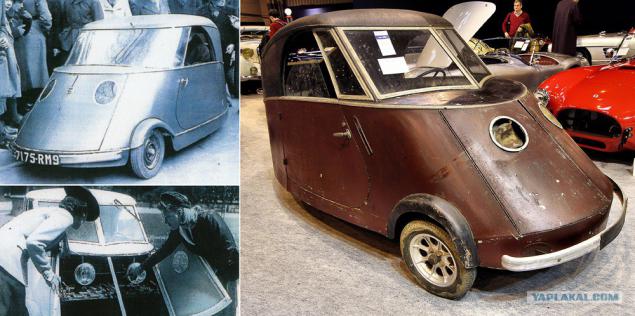
And what do you think? Resourceful French said the creation of electric vehicles! How do you double cabin on wheels by Pierre Faure? Light body with aviation obvious motives behind the electric motor in the front and six batteries. It's not difficult aspirin. Power reserve - about 50 km. Maximum speed - 40 km / h. And most importantly - no violations of the "new order»!
If Faure of Pierre before his elektrokabinki anybody especially not heard that name in the Peugeot while thundered the whole of Europe. To create the electric Peugeot family, however, pushed the same reason - a ban on the sale of petrol models. Name Peugeot VLV, debuted May 1, 1941, stands for Voiture Légère de Ville, ie the "light city car." More traditional in matters of design, rather than design Foret, VLV accelerated to 36 km / h, and the assurances of the creators, on the charge to the battery ran for about 80 km. Surprisingly, the VLV, do not consume a gram of gasoline would not hit invaders. The Germans forbade the release of electric car when the conveyor Peugeot has collected only 377 copies.
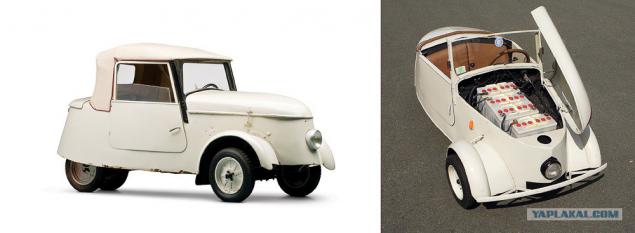
3. The most glamorous - ALCA VOLPE (ITALY 1947)
It could be the most beautiful of the microcar, but remained only a prototype. In fact, the design of this roadster is not accidental allusions to sports models Alfa Romeo. It is thanks to catchy appearance on the "fox" (translated from the Italian model name) managed to collect a lot of orders. But of a dozen assembled prototypes none was hardly 100 percent efficient. Why is that? So in fact the engine of the car was not at all! Problems with suppliers not solved - ALCA Volpe remained curious design exercise.

4. MOST cardboard - LLOYD LP300 (GERMANY 1950)
Machines of this brand during the life called "leykoplastyrevymi bombers." And there were good reasons. Lloyd - «Daughter," the famous German car manufacturer Borgward - in the early 50's famous series of subcompact and very affordable minicars. The difficult economic situation, straining the supply of steel, and the need to make the car as easy and cheap are the reason that the body Lloyd 300 was made of wood and plywood .... Is that the outer panel further snug cloth and kozhzamom. Now you know where legs grow "leykoplastyrevogo" nickname? Of course, the owners of the habit to seal minor injuries "paint" what comes to hand. Just. Brilliant.

5. Nicest - KLEINSCHNITTGER F125 (GERMANY 1950)
In the photo, he seems a toy, however, we have vsamdelishny, however, very rare car. The German engineer Paul Klyaynshnitger pondered microcar concept still in the 30s of the last century, but the idea implemented only after the war. Using only parts of old military vehicles and aircraft, Paul built a Roadster-handsome. Pretty sophisticated tubular frame, lightweight aluminum body, its forms subtly reminiscent of children's pedal avtomobilchiki those years, and 5-horsepower motorcycle dvuhtatknik under the hood. The options offered F125 electric starter (in the database - a kick-starter) and rare for that time turn signals from Hella. All were released about three thousand kids, and Klyaynshnitgeru able to sell licenses in Belgium and Holland.
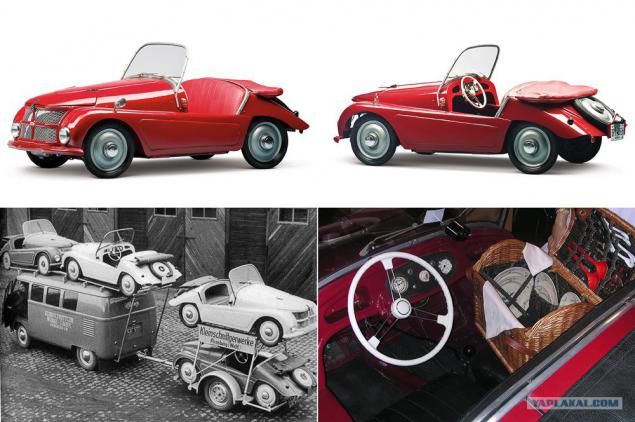
6. The most insane - HOFFMANN (Germany, 1951)
There are cars, when you look at that there is only one question to their creators - guys, what are you thinking? Amazing monocab Hoffmann is just one of them. And appearance has nothing to do with it. Just think, eka wonder, the body in the form of an egg! But pay attention to proportion. Egg-and three-Hoffmann was very wide, only slightly reaching for up to two meters. This circumstance in a compact wheelbase determined very erratic behavior of the machine on the road. Worse, in the desire to surprise at all costs the authors of "Hoffmann" managed to make only the rear wheel! In short, to manage the technical casus required special skills. Fortunately, funny, but stupid Hoffmann released in a single copy.
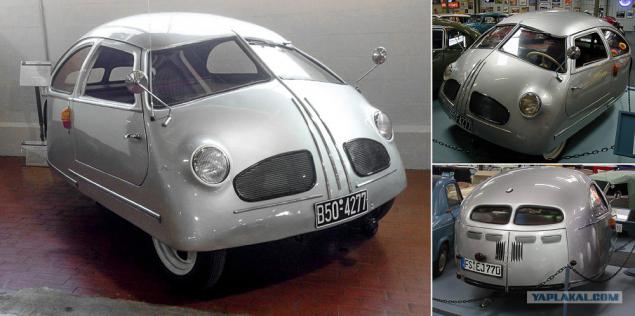
7. The most famous - MESSERSCHMITT KR175 / 200 (Germany, 1953) / HEINKEL KABIN (GERMANY 1956)
Apart from "Izetta" (she is so well known that we have even decided not to mention it on the list) is this sweet couple - the archetypal example of "bubble cars' 50s. Two large German aviakontserna Germany after the war for a while deprived of the right to produce airplanes and threw its efforts on the production of wheeled vehicles.

Messerschmitt KR175 appeared thanks to the perseverance of the former technique of "Luftwaffe" Fendi Flittsera. Developer motorized wheelchair, he appealed to "Messerschmitt" with the idea of joint production of microcars. So there was a KR175, literally Kabinroller, ie "scooter with a body." 175 cc single-cylinder two-stroke, 4-speed manual (reverse gear is absent) and clean the aircraft access to the salon - a hinged cap - that's all the love. The machine was an instant hit. Partly due to the simplicity and cost-effectiveness, in part because of the very high quality of manufacturing.
"Henkel" hit the market later, but increasingly resembled a passenger car than a phone booth on wheels. In the interior the driver and passenger got through a single door but the front of the familiar, the transmission - a miracle! - There was a reverse gear, and a four-cylinder (!) The actual design of the motor gave out 10 hp and the car accelerates to 90 km / h. But the main thing - unlike most competitors, "Henkel" work quietly and, sorry, do not stink of burning oil. Sorry, but the initial success of the engineers turned the heads of aviation giants. No "Messerschmitt" or "Henkel" do not seem to believe that the difficult times for the European run so fast. And with the advent of the turn of the 60 models such as Renault 4 and the Austin Mini, the popularity of "bubble cars" came to naught.

8. The most unexpected - AC PETITE (UK, 1953)
Of course, when referring to the brand AC in the head immediately climb sexy lines of the legendary "Cobras". Hard to believe, but in the company's model range were far less pretentious cars. Back in 1947, commissioned by the British Ministry of pensions AC began to produce sidecars for the disabled and the poor. Little "Petite" fully meets the requirements of the time. They, however, and there were only two. Compact size - only two seats in the general banquette in the cabin - and profitability. 35-horsepower two-stroke motorcycle carrying not very, very richly fragrant, but not too much burst, costs only 4 liters per hundred runs. In this three-AC also looked very charming. In short, one of the prettiest microcar not only their time, but in the overall classification.

9. The most noble - ALLARD CLIPPER (UK, 1953)
Another expert on sports cars, which is serious for Europe '50s turned to the actual topic microcar. Racing "Allard" in 1952 won the Monte Carlo Rally in the overall classification, and only a year of the London studios of the company rolled out "Clipper". Incidentally, while the car seat with the formula 2 +2 touted as the world's first car with a fiberglass body. Sydney Allard And he called his body microcar "indestructible." Oh, if only that were true! The rest of the baby is more traditional - two-stroke motorcycle, chain drive. Sorry to mass production "Clipper" never swam. According to various sources, the general circulation models do not exceed 50 copies.

10. MOST AVIATION - INTER 175A (FRANCE 1955)
Agree, if this boat, alone on wheels add tail and propeller aircraft will natural! It is not surprising, because Inter 175 - the brainchild of the French aircraft building company SNCAN, which published the planes under the brand Nord. And aviation motifs at the "Inter" at every turn. Access to the salon opened flip-roof, which in the manner of an air properly called "lantern". The steering wheel is again more like a steering wheel. But the main trick the machine in another. In early versions of "Inter" front wheels tucked inside, making it easier parking in tight spots. The width of the machine reduced to 45 cm! In just two years the French managed to collect about 200 "Inter".

11. The most exotic - FUJI CABIN (JAPAN 1955)
The country that gave the world kei-cars of old, famous for tiny cars. In the end, the first passenger Mazda and Subaru can be considered a microcar. But Fuji Sabin even smaller, with a wider audience is almost unknown. "Booth", presented at the Tokyo Motor Show 1955, was an aerodynamically-designed fiberglass body, dressed in the motorollernoe chassis. Machine looked very cheerful, and went as an ordinary bubble car. Not fast, but economical and smoky. Too bad, high prices and a complete lack of advertising support Fuji did not help to gain a foothold in the market. Issued There were about a hundred pieces.

12. MOST cartoon - ZUNDAPP JANUS (GERMANY 1956)
Of course, this machine we all know thanks to the cartoon Cars 2. It is a pity, in Hollywood got the unenviable role of the car. Bad temper professor Tsyundappa does not fit in with the charming appearance of the microcar. By the way, Janus is not designed by the motorcycle company Zundapp, both logical to assume, and the engineers of the company aircraft Dornier. Just did not have experience in the production of cars pilots had entrusted the production of a little more versed in the issue of motorcyclists. "Janus" can be called a bubble-car deluxe. He was a four-room - and the driver and passengers sitting back to back, and the door is not located on the sides and front and rear. Suspension on the racks, "McPherson" in a circle provides a very comfortable smooth ride and brakes on all wheels are hydraulically c uncommon for cars, kids. Unfortunately, as a unique design and layout of Janus it was too expensive for bubble cars and too spartan for full cars. Stuck between segments Zundapp was amusing and technical experiments.

13. MOST motorcycle - BRUETSCH MOPETTA (GERMANY 1956)
Lord Egon Bryutsha can equally well be called as a romantic by car and an ordinary follower of Ostap Bender. In the life of a German engineer earned numerous design microcar hoping to sell the license for their production to large companies. Of the many amusing craft Bryutsha - "Mopetta" (another name for the model - Rollera), perhaps the most famous. In 1956, it was touted as the smallest car in the world. More like a three-wheeled motorcycle, the machine was equipped with a fiberglass body, a two-stroke 50 cc engine with the kick starter and a 3-speed manual. In theory, the buyer received a maximum speed of 45 km / h, a single room, a complete lack of protection from the elements, and most importantly - kiloton attention. At one time even interested in the project "Opel", but ultimately collected only 14 prototypes.
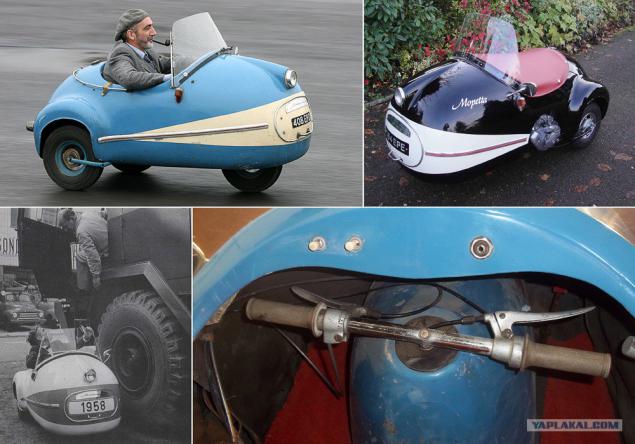
14. The most advanced - CITROEN C10 COCCINELLE (FRANCE 1956)
If "sitroenovskoy" ladybug got to the conveyor, you probably would have grabbed the title of the most advanced car era. It is not surprising, because her godfather himself Henri Lefebvre - ingenious creator of the legendary "the Traction Avan" and DS, engineer, for which there is simply not taboo. Conceived as an intermediate model between the 2CV and DS19, «koksinel" has excellent aerodynamics (body shape resembled the ideal in terms of streamlining drop of water) and extremely low birth weight (less than 400 kg snaryazhenka). In this scenario, even the 12-hp 425-cc motor of the "Deux shvo" did not seem a dead. Add to this the hydropneumatic suspension, four-seater cabin and reclining up elements of glass - poured out the wings of a ladybug. Sorry, but eventually I received a start in life orthodox Ami 6, and "koksinel" dutifully trotted into historical reservists "Citroen».
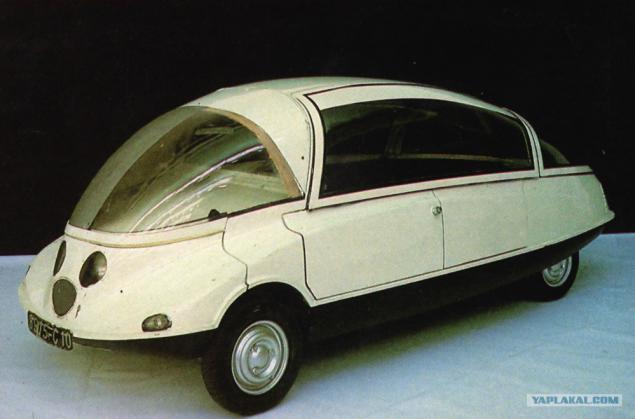
15. MOST indestructible - TRIVER (SPAIN, 1957)
Indestructible it literally. The fact that the Spanish mikroven - the brainchild of the company, before specializing in the production of safes. That is why the thickness of the body panels "Trivero" reached 3 mm! In addition, the Spanish were safe on wheels "normal" side doors and the interior of the formula 2 +2 seats. True if the length of 2 m 67 cm machine weighed half a ton. Well, still, at a certain thickness of the body panels! Logically, the maximum speed earlier with a 14-horsepower engine does not exceed 18 km / h.

16. The most stylish - PIAGGIO VESPA 400 (Italy, 1957)
No, no, no mistake. And by that sweet name of every biker at one time produced vehicles. In the end, the examples when the motorcycle company successfully turned-automaker, uncommon: Opel, BMW, Honda ... Not surprisingly, the most famous in Europe motobrendy the second half of the 50s, too, decided to try his luck. The order for the development and production of two-door mikroavtomobilchika placed on the French engineering company ACMA. And in September 1957, four-wheeled Vespa pathetic presented in Monaco. Technically, the machine does not become a revelation, but thanks to a pretty attractive face, and untwisted and even then fashionable name initially enjoyed good demand. However, the 12,000 cars sold in 1958, were the highest achievement of good-looking, but there was already a spent popularity avtomobilchika microcar. Continuation of "Vespa" -Theme never received.
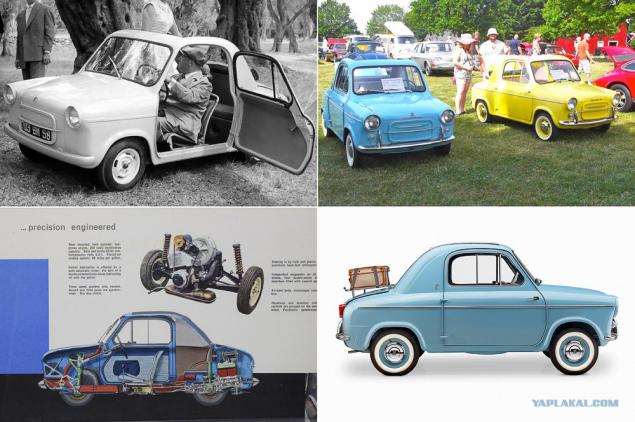
17. MOST SPORTS - FRISKY SPORT (UK, 1958)
Exactly at the height of the Suez crisis, a Flauer Raymond, a businessman and race car driver, he decided to build his own microcar. With firm Henry Meadow Limited of Wolverhampton, he agreed to supply engines and design, among other things, ordered the Italians from Vignale. However, a funny odnobemnichek with doors à la gullwing did not accept Mr. Flauera - in the manufacture of the machine would be too costly. Before conveyor eventually got another little car - a two-door sports roadster Frisky Sport. 16-strong baby justified ambitious prefix in the name. When the mass of a little more than 300 kg machine overclocked to 105 km / h. For the segment almost record! Later in the range of models it appeared coupe and trehkolesnik, but the entry of Mini put an end to the company Mr. Flauera.
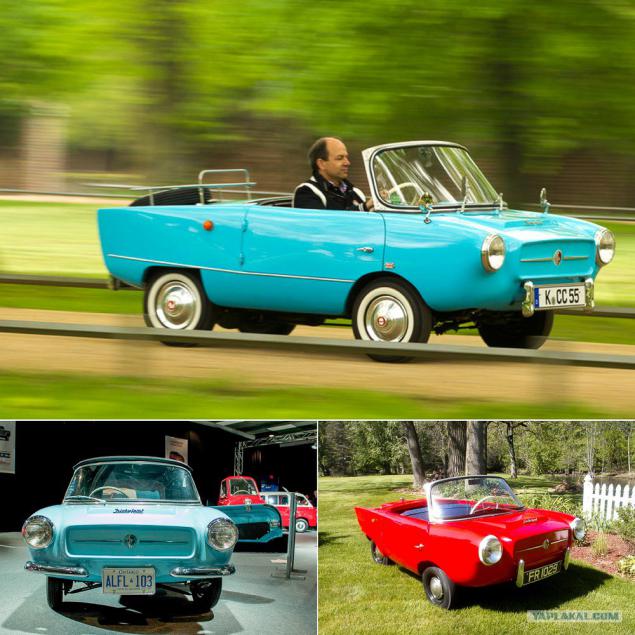
18. dearest - SMZ-P-3A (USSR, 1958)
In the Soviet Union microcars appeared almost simultaneously with Europe.
Source:
On this day, exactly 75 years ago there was a very entertaining event. April 28, 1939 On his debut Crosley Series 1A - the first American microcar!

Avtomobilchik with a wheelbase of two meters, 10 hp 600 cc engine from a lawn sprayer and extremely curious and charming appearance itself. Yet it is important that the anniversary Crosley gave us the occasion to remember the microcar as such - cars, cars for which some believe not all.
What is generally considered microcar? Strict dogmatic formulations do not exist. As there is no single accepted name for such vehicles. In Japan they are called key-penalties, in the UK at the time was a popular term "bubble-Kars" (car-bubbles), the Soviet Union was called kids minicars and sometimes invalidkoy. Choose on taste!
For the vast tribe of automotive small things can safely reckon cars of no more than 3, 5 meters and engine capacity of up to 1 liter and the interior, as a rule, no more than two persons. However, sometimes seating ranges, as well as the number of doors, wheels and cylinders.
Well, perhaps that's enough science-boredom. Now is the time to arrange in order of most-most microcars of the past years. Gentlemen, crank your motors!
Posted in [mergetime] 1398671894 [/ mergetime]
1. MOST AMERICAN - CROSLEY 1A (USA 1939)
The culprit of today's historical perspective curious by the fact that he was born overseas. For the Yankees, as is well known, even in the most difficult periods of its history flatly refused to ride on small cars. What has prompted Powell Crosley, inventor, businessman and a millionaire of Cincinnati, to start production of subcompact? That is still a mystery ...
Posted in [mergetime] 1398671942 [/ mergetime]
We offer a wide range of bodies: a sedan, station wagon, convertible and even an SUV. And one time, it seemed - Mr. Crosley plan might work. In 1948, sales exceeded 28 thousand microcar. Alas, on the successfully completed. Big Detroit trio steadily increasing post-war production, offering more and more new, large, powerful and inexpensive cars. The Americans turned away from the corny kids. However, as you would expect ...

2. MOST ELECTRIC - FAURE PFA (FRANCE 1940) / PEUGEOT VLV (France, 1941)
The root cause of the emergence of ultra-compact car - it's limitations. Restrictions in turn can be very different from the low purchasing power of the population ... to the requirements of the occupation authorities. In 1940, German troops occupied France, Paris and the new owners immediately banned local automobile companies to produce gasoline cars. All fuel is passed to the needs of the Wehrmacht.

And what do you think? Resourceful French said the creation of electric vehicles! How do you double cabin on wheels by Pierre Faure? Light body with aviation obvious motives behind the electric motor in the front and six batteries. It's not difficult aspirin. Power reserve - about 50 km. Maximum speed - 40 km / h. And most importantly - no violations of the "new order»!
If Faure of Pierre before his elektrokabinki anybody especially not heard that name in the Peugeot while thundered the whole of Europe. To create the electric Peugeot family, however, pushed the same reason - a ban on the sale of petrol models. Name Peugeot VLV, debuted May 1, 1941, stands for Voiture Légère de Ville, ie the "light city car." More traditional in matters of design, rather than design Foret, VLV accelerated to 36 km / h, and the assurances of the creators, on the charge to the battery ran for about 80 km. Surprisingly, the VLV, do not consume a gram of gasoline would not hit invaders. The Germans forbade the release of electric car when the conveyor Peugeot has collected only 377 copies.

3. The most glamorous - ALCA VOLPE (ITALY 1947)
It could be the most beautiful of the microcar, but remained only a prototype. In fact, the design of this roadster is not accidental allusions to sports models Alfa Romeo. It is thanks to catchy appearance on the "fox" (translated from the Italian model name) managed to collect a lot of orders. But of a dozen assembled prototypes none was hardly 100 percent efficient. Why is that? So in fact the engine of the car was not at all! Problems with suppliers not solved - ALCA Volpe remained curious design exercise.

4. MOST cardboard - LLOYD LP300 (GERMANY 1950)
Machines of this brand during the life called "leykoplastyrevymi bombers." And there were good reasons. Lloyd - «Daughter," the famous German car manufacturer Borgward - in the early 50's famous series of subcompact and very affordable minicars. The difficult economic situation, straining the supply of steel, and the need to make the car as easy and cheap are the reason that the body Lloyd 300 was made of wood and plywood .... Is that the outer panel further snug cloth and kozhzamom. Now you know where legs grow "leykoplastyrevogo" nickname? Of course, the owners of the habit to seal minor injuries "paint" what comes to hand. Just. Brilliant.

5. Nicest - KLEINSCHNITTGER F125 (GERMANY 1950)
In the photo, he seems a toy, however, we have vsamdelishny, however, very rare car. The German engineer Paul Klyaynshnitger pondered microcar concept still in the 30s of the last century, but the idea implemented only after the war. Using only parts of old military vehicles and aircraft, Paul built a Roadster-handsome. Pretty sophisticated tubular frame, lightweight aluminum body, its forms subtly reminiscent of children's pedal avtomobilchiki those years, and 5-horsepower motorcycle dvuhtatknik under the hood. The options offered F125 electric starter (in the database - a kick-starter) and rare for that time turn signals from Hella. All were released about three thousand kids, and Klyaynshnitgeru able to sell licenses in Belgium and Holland.

6. The most insane - HOFFMANN (Germany, 1951)
There are cars, when you look at that there is only one question to their creators - guys, what are you thinking? Amazing monocab Hoffmann is just one of them. And appearance has nothing to do with it. Just think, eka wonder, the body in the form of an egg! But pay attention to proportion. Egg-and three-Hoffmann was very wide, only slightly reaching for up to two meters. This circumstance in a compact wheelbase determined very erratic behavior of the machine on the road. Worse, in the desire to surprise at all costs the authors of "Hoffmann" managed to make only the rear wheel! In short, to manage the technical casus required special skills. Fortunately, funny, but stupid Hoffmann released in a single copy.

7. The most famous - MESSERSCHMITT KR175 / 200 (Germany, 1953) / HEINKEL KABIN (GERMANY 1956)
Apart from "Izetta" (she is so well known that we have even decided not to mention it on the list) is this sweet couple - the archetypal example of "bubble cars' 50s. Two large German aviakontserna Germany after the war for a while deprived of the right to produce airplanes and threw its efforts on the production of wheeled vehicles.

Messerschmitt KR175 appeared thanks to the perseverance of the former technique of "Luftwaffe" Fendi Flittsera. Developer motorized wheelchair, he appealed to "Messerschmitt" with the idea of joint production of microcars. So there was a KR175, literally Kabinroller, ie "scooter with a body." 175 cc single-cylinder two-stroke, 4-speed manual (reverse gear is absent) and clean the aircraft access to the salon - a hinged cap - that's all the love. The machine was an instant hit. Partly due to the simplicity and cost-effectiveness, in part because of the very high quality of manufacturing.
"Henkel" hit the market later, but increasingly resembled a passenger car than a phone booth on wheels. In the interior the driver and passenger got through a single door but the front of the familiar, the transmission - a miracle! - There was a reverse gear, and a four-cylinder (!) The actual design of the motor gave out 10 hp and the car accelerates to 90 km / h. But the main thing - unlike most competitors, "Henkel" work quietly and, sorry, do not stink of burning oil. Sorry, but the initial success of the engineers turned the heads of aviation giants. No "Messerschmitt" or "Henkel" do not seem to believe that the difficult times for the European run so fast. And with the advent of the turn of the 60 models such as Renault 4 and the Austin Mini, the popularity of "bubble cars" came to naught.

8. The most unexpected - AC PETITE (UK, 1953)
Of course, when referring to the brand AC in the head immediately climb sexy lines of the legendary "Cobras". Hard to believe, but in the company's model range were far less pretentious cars. Back in 1947, commissioned by the British Ministry of pensions AC began to produce sidecars for the disabled and the poor. Little "Petite" fully meets the requirements of the time. They, however, and there were only two. Compact size - only two seats in the general banquette in the cabin - and profitability. 35-horsepower two-stroke motorcycle carrying not very, very richly fragrant, but not too much burst, costs only 4 liters per hundred runs. In this three-AC also looked very charming. In short, one of the prettiest microcar not only their time, but in the overall classification.

9. The most noble - ALLARD CLIPPER (UK, 1953)
Another expert on sports cars, which is serious for Europe '50s turned to the actual topic microcar. Racing "Allard" in 1952 won the Monte Carlo Rally in the overall classification, and only a year of the London studios of the company rolled out "Clipper". Incidentally, while the car seat with the formula 2 +2 touted as the world's first car with a fiberglass body. Sydney Allard And he called his body microcar "indestructible." Oh, if only that were true! The rest of the baby is more traditional - two-stroke motorcycle, chain drive. Sorry to mass production "Clipper" never swam. According to various sources, the general circulation models do not exceed 50 copies.

10. MOST AVIATION - INTER 175A (FRANCE 1955)
Agree, if this boat, alone on wheels add tail and propeller aircraft will natural! It is not surprising, because Inter 175 - the brainchild of the French aircraft building company SNCAN, which published the planes under the brand Nord. And aviation motifs at the "Inter" at every turn. Access to the salon opened flip-roof, which in the manner of an air properly called "lantern". The steering wheel is again more like a steering wheel. But the main trick the machine in another. In early versions of "Inter" front wheels tucked inside, making it easier parking in tight spots. The width of the machine reduced to 45 cm! In just two years the French managed to collect about 200 "Inter".

11. The most exotic - FUJI CABIN (JAPAN 1955)
The country that gave the world kei-cars of old, famous for tiny cars. In the end, the first passenger Mazda and Subaru can be considered a microcar. But Fuji Sabin even smaller, with a wider audience is almost unknown. "Booth", presented at the Tokyo Motor Show 1955, was an aerodynamically-designed fiberglass body, dressed in the motorollernoe chassis. Machine looked very cheerful, and went as an ordinary bubble car. Not fast, but economical and smoky. Too bad, high prices and a complete lack of advertising support Fuji did not help to gain a foothold in the market. Issued There were about a hundred pieces.

12. MOST cartoon - ZUNDAPP JANUS (GERMANY 1956)
Of course, this machine we all know thanks to the cartoon Cars 2. It is a pity, in Hollywood got the unenviable role of the car. Bad temper professor Tsyundappa does not fit in with the charming appearance of the microcar. By the way, Janus is not designed by the motorcycle company Zundapp, both logical to assume, and the engineers of the company aircraft Dornier. Just did not have experience in the production of cars pilots had entrusted the production of a little more versed in the issue of motorcyclists. "Janus" can be called a bubble-car deluxe. He was a four-room - and the driver and passengers sitting back to back, and the door is not located on the sides and front and rear. Suspension on the racks, "McPherson" in a circle provides a very comfortable smooth ride and brakes on all wheels are hydraulically c uncommon for cars, kids. Unfortunately, as a unique design and layout of Janus it was too expensive for bubble cars and too spartan for full cars. Stuck between segments Zundapp was amusing and technical experiments.

13. MOST motorcycle - BRUETSCH MOPETTA (GERMANY 1956)
Lord Egon Bryutsha can equally well be called as a romantic by car and an ordinary follower of Ostap Bender. In the life of a German engineer earned numerous design microcar hoping to sell the license for their production to large companies. Of the many amusing craft Bryutsha - "Mopetta" (another name for the model - Rollera), perhaps the most famous. In 1956, it was touted as the smallest car in the world. More like a three-wheeled motorcycle, the machine was equipped with a fiberglass body, a two-stroke 50 cc engine with the kick starter and a 3-speed manual. In theory, the buyer received a maximum speed of 45 km / h, a single room, a complete lack of protection from the elements, and most importantly - kiloton attention. At one time even interested in the project "Opel", but ultimately collected only 14 prototypes.

14. The most advanced - CITROEN C10 COCCINELLE (FRANCE 1956)
If "sitroenovskoy" ladybug got to the conveyor, you probably would have grabbed the title of the most advanced car era. It is not surprising, because her godfather himself Henri Lefebvre - ingenious creator of the legendary "the Traction Avan" and DS, engineer, for which there is simply not taboo. Conceived as an intermediate model between the 2CV and DS19, «koksinel" has excellent aerodynamics (body shape resembled the ideal in terms of streamlining drop of water) and extremely low birth weight (less than 400 kg snaryazhenka). In this scenario, even the 12-hp 425-cc motor of the "Deux shvo" did not seem a dead. Add to this the hydropneumatic suspension, four-seater cabin and reclining up elements of glass - poured out the wings of a ladybug. Sorry, but eventually I received a start in life orthodox Ami 6, and "koksinel" dutifully trotted into historical reservists "Citroen».

15. MOST indestructible - TRIVER (SPAIN, 1957)
Indestructible it literally. The fact that the Spanish mikroven - the brainchild of the company, before specializing in the production of safes. That is why the thickness of the body panels "Trivero" reached 3 mm! In addition, the Spanish were safe on wheels "normal" side doors and the interior of the formula 2 +2 seats. True if the length of 2 m 67 cm machine weighed half a ton. Well, still, at a certain thickness of the body panels! Logically, the maximum speed earlier with a 14-horsepower engine does not exceed 18 km / h.

16. The most stylish - PIAGGIO VESPA 400 (Italy, 1957)
No, no, no mistake. And by that sweet name of every biker at one time produced vehicles. In the end, the examples when the motorcycle company successfully turned-automaker, uncommon: Opel, BMW, Honda ... Not surprisingly, the most famous in Europe motobrendy the second half of the 50s, too, decided to try his luck. The order for the development and production of two-door mikroavtomobilchika placed on the French engineering company ACMA. And in September 1957, four-wheeled Vespa pathetic presented in Monaco. Technically, the machine does not become a revelation, but thanks to a pretty attractive face, and untwisted and even then fashionable name initially enjoyed good demand. However, the 12,000 cars sold in 1958, were the highest achievement of good-looking, but there was already a spent popularity avtomobilchika microcar. Continuation of "Vespa" -Theme never received.

17. MOST SPORTS - FRISKY SPORT (UK, 1958)
Exactly at the height of the Suez crisis, a Flauer Raymond, a businessman and race car driver, he decided to build his own microcar. With firm Henry Meadow Limited of Wolverhampton, he agreed to supply engines and design, among other things, ordered the Italians from Vignale. However, a funny odnobemnichek with doors à la gullwing did not accept Mr. Flauera - in the manufacture of the machine would be too costly. Before conveyor eventually got another little car - a two-door sports roadster Frisky Sport. 16-strong baby justified ambitious prefix in the name. When the mass of a little more than 300 kg machine overclocked to 105 km / h. For the segment almost record! Later in the range of models it appeared coupe and trehkolesnik, but the entry of Mini put an end to the company Mr. Flauera.

18. dearest - SMZ-P-3A (USSR, 1958)
In the Soviet Union microcars appeared almost simultaneously with Europe.
Source:


